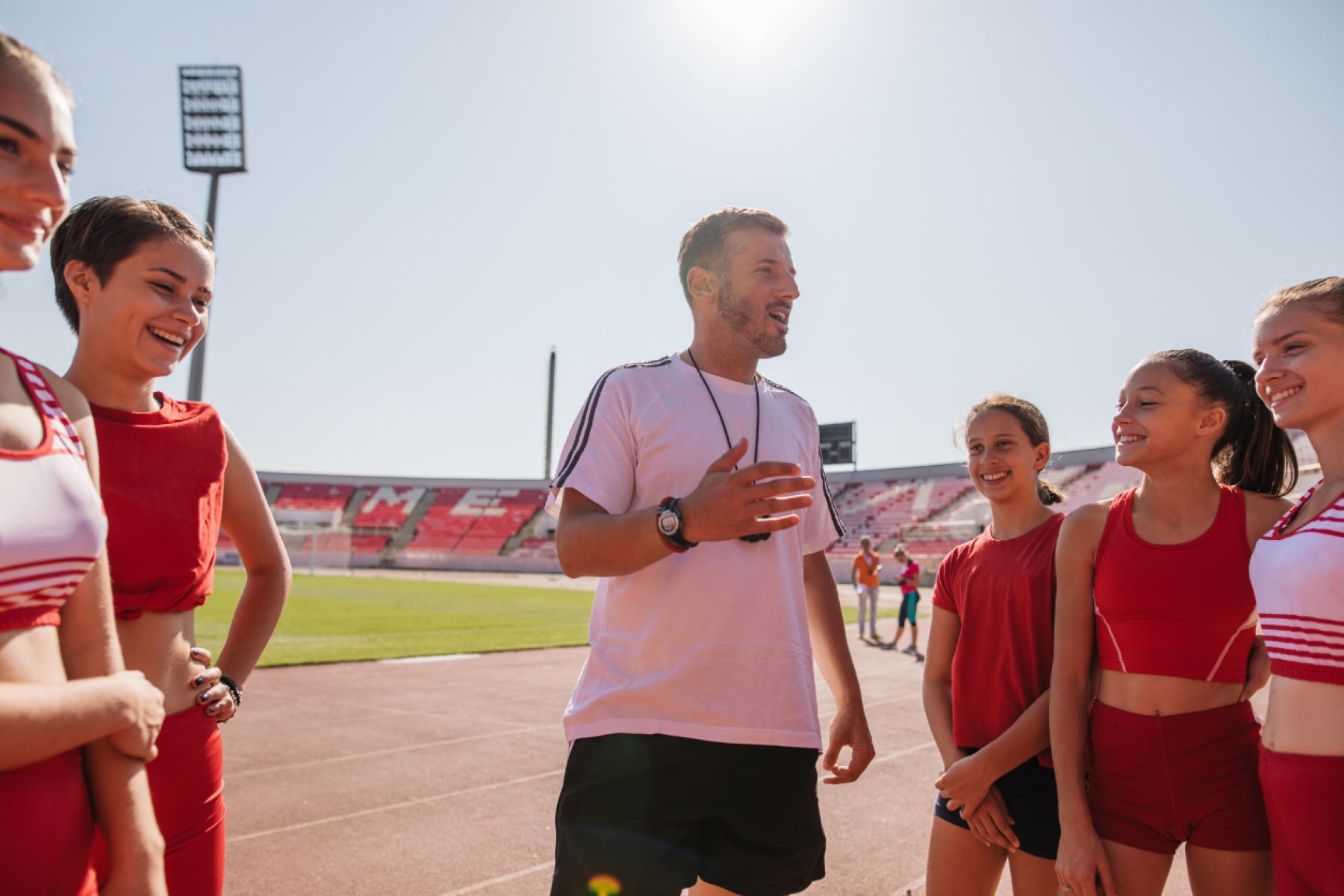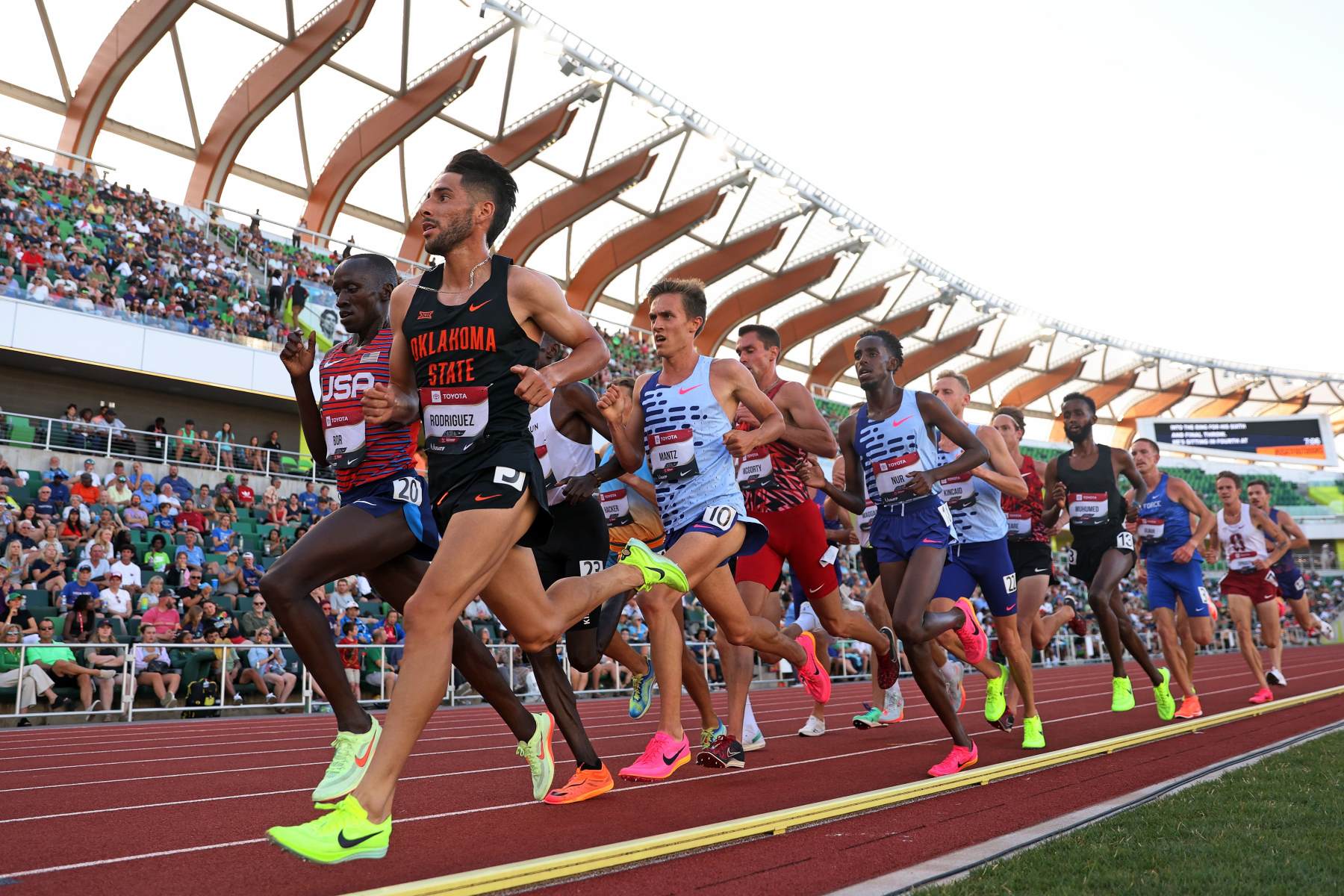

Featured
How To Get Good At Track And Field
Modified: January 2, 2024
Featured: Learn the secrets to becoming a track and field expert with our comprehensive guide on how to improve your skills and succeed in this competitive sport.
Introduction
Welcome to the exciting world of track and field! Whether you are a beginner looking to try out a new sport or a seasoned athlete hoping to improve your performance, this article will provide you with a comprehensive guide on how to get good at track and field. Track and field is a highly diverse sport that encompasses a range of events, from sprints to jumps to throws. It requires a unique combination of speed, agility, strength, and technique.
In this article, we will explore various aspects of track and field training, including finding the right event for you, setting goals, building endurance, developing speed and power, improving technique, strength training, plyometric exercises, proper nutrition and hydration, injury prevention and recovery, and mental preparation and focus.
Track and field is not only a physically demanding sport but also a mentally challenging one. It requires discipline, dedication, and perseverance. By following the guidance in this article, you will not only improve your athletic performance but also gain a deeper appreciation for the sport.
Whether you aim to compete at the highest level or simply want to enjoy the sport and stay fit, track and field can offer you a rewarding and fulfilling experience. So, let’s dive in and discover how to maximize your potential and achieve your goals in the world of track and field.
Finding the Right Event for You
One of the first steps in becoming good at track and field is to identify the event that suits your strengths and interests. Track and field offers a wide range of events, including sprinting, long distance running, jumping, throwing, and hurdling. Each event requires different skill sets and physical attributes, so it’s essential to choose the event that aligns with your abilities and preferences.
Start by assessing your natural abilities. Are you naturally fast and explosive? If so, sprinting events such as the 100-meter or 200-meter dash may be a good fit for you. If you have endurance and enjoy longer distances, consider middle-distance or long-distance running events like the 800-meter or 1500-meter race.
Are you strong and have good coordination? Field events like long jump, high jump, shot put, or javelin throw may be areas where you can excel. If you possess good speed and the ability to clear obstacles, hurdling events could be a great option.
Take into consideration your body type and physical attributes. Taller athletes may find success in jumping or throwing events, while shorter athletes may have an advantage in sprints or hurdles.
It is also important to consider your interests and passion. If you have a genuine interest in a particular event, you are more likely to stay motivated and committed to training. Reflect on which events you enjoy watching or feel drawn to when watching track and field competitions.
Once you have identified a few events that align with your abilities and interests, try them out! Attend practice sessions or join a local track and field club to gain hands-on experience. This will give you a better sense of which event feels right for you and allows you to interact with experienced coaches and athletes who can provide guidance and support.
Remember, finding the right event takes time and experimentation. It is not uncommon to try out different events before settling on the one that suits you best. Be open to exploring different options and don’t be discouraged if it takes a while to discover your ideal event. The key is to find an event that brings you joy and allows you to perform at your best.
Setting Goals
Setting clear and specific goals is crucial for success in track and field. Goals provide focus, motivation, and direction for your training. Whether you are a beginner or an experienced athlete, establishing goals will help you measure progress and stay committed to your training program.
When setting goals, it’s important to make them SMART: Specific, Measurable, Achievable, Relevant, and Time-bound. Specific goals clearly define what you want to accomplish. For example, instead of setting a vague goal like “improve my sprinting,” you could set a specific goal like “decrease my 100-meter dash time by 0.5 seconds.”
Measurable goals allow you to track your progress. Make sure your goals have a quantifiable measurement, such as a time, distance, or number of repetitions. This will enable you to assess your improvement and make adjustments to your training as needed.
Achievable goals are realistic and attainable. Consider your current fitness level, skill level, and the time you have available for training. Set challenging goals that push you outside of your comfort zone but are still within reach.
Relevant goals align with your overall aspirations and are meaningful to you. Reflect on what you want to achieve in track and field and why it matters to you. Setting goals that are personally significant will help you stay motivated and committed to your training.
Time-bound goals have a specific deadline or timeframe. Setting a deadline creates a sense of urgency and helps you stay accountable. Break down your long-term goals into smaller, short-term goals to make them more manageable and trackable.
In addition to the overall goal, consider setting process goals that focus on the daily or weekly actions necessary to achieve your main objective. These process goals can be related to training volume, consistency, technique improvement, or recovery strategies. By focusing on the process, you will build a strong foundation for success.
Remember, goals should be flexible and adjustable. As you progress and gain more experience, you may need to revise your goals to reflect your changing abilities and aspirations. Regularly evaluate your goals and adapt them as necessary to ensure they continue to challenge and motivate you.
Write down your goals and keep them in a visible place as a constant reminder of what you are working towards. Share your goals with a coach or training partner who can provide support, accountability, and guidance throughout your journey.
Setting goals is not just about achieving specific outcomes; it’s also about personal growth and development. Embrace the process, celebrate small victories along the way, and stay committed to your training. With clear goals in place, you are well-equipped to excel in track and field.
Building Endurance
Endurance is a fundamental component of track and field that plays a crucial role in many events, from long-distance running to relays. Developing endurance will not only improve your performance but also allow you to maintain a strong pace throughout a race or event. Here are some essential tips to build endurance in track and field:
1. Consistent Cardiovascular Training: Engage in regular cardiovascular exercises such as running, swimming, cycling, or rowing. Aim for at least three to four sessions per week, gradually increasing the duration and intensity over time.
2. Long Slow Distance Runs: Incorporate long slow distance runs into your training regimen. These are steady-paced runs that are longer in duration, helping to develop stamina and mental resilience. Start with a comfortable distance and gradually increase the mileage each week.
3. Interval Training: Integrate interval training into your workouts. This involves alternating between periods of high-intensity effort and active recovery. For example, perform sprints for a specific distance or time and then jog or walk to recover before repeating the cycle.
4. Tempo Runs: Tempo runs involve running at a comfortably hard pace, just below your threshold. These workouts improve your ability to sustain a faster pace for an extended period. Start with shorter tempo runs and gradually increase the duration over time.
5. Hill Training: Incorporate hill sprints or hill repeats into your training routine. Running uphill challenges your cardiovascular system and builds leg strength, enhancing your overall endurance. Remember to maintain good form and engage your arms and core when running uphill.
6. Cross-Training: Include cross-training activities such as swimming, cycling, or circuit training to work different muscle groups and reduce the risk of overuse injuries. Cross-training also provides variety to your training routine and helps prevent boredom.
7. Rest and Recovery: Allow time for proper rest and recovery. Endurance training puts stress on your body, and adequate rest is essential for muscle repair and growth. Incorporate rest days into your training plan and prioritize sleep and nutrition to support your recovery.
8. Proper Nutrition: Fuel your body with a well-balanced diet that includes carbohydrates, protein, and healthy fats. Pay attention to your pre- and post-workout nutrition to optimize energy levels and aid in muscle recovery.
9. Gradual Progression: Gradually increase the duration, intensity, or distance of your workouts. Avoid sudden spikes in training volume, as this can increase the risk of injury. Listen to your body and adjust your training as needed.
10. Mental Strength: Endurance training is not just physical; it is also mental. Develop mental resilience by incorporating visualization techniques, positive self-talk, and goal setting into your training. Cultivating a strong mindset will help you push through fatigue and perform at your best.
Remember, building endurance takes time and consistency. Be patient and trust the process. As your endurance improves, you will notice a difference in your performance and overall stamina on the track. Incorporate these strategies into your training routine and watch your endurance soar.
Developing Speed and Power
Speed and power are essential components in track and field, particularly in sprinting and jumping events. Developing speed and power will enable you to generate explosive movements and achieve faster times or greater distances. Here are some key strategies to develop speed and power in track and field:
1. Sprint Training: Incorporate sprint workouts into your training routine to improve your acceleration and top-end speed. This can include various drills such as flying sprints, resisted sprints with sleds or resistance bands, or hill sprints. Focus on proper sprint mechanics, including arm swing, knee drive, and maintaining an optimal body position.
2. Plyometric Exercises: Plyometric exercises are explosive movements that involve rapid muscle contractions. Incorporate exercises such as box jumps, hurdle hops, and depth jumps into your training routine. These movements help develop power, reactive strength, and the ability to generate force quickly.
3. Strength Training: Incorporate strength training exercises to enhance power and speed. Focus on compound exercises like squats, deadlifts, power cleans, and lunges that engage multiple muscle groups. Perform these exercises with proper form and gradually increase the weight and intensity over time.
4. Resistance Training: Utilize resistance training methods such as resistance bands, weight vests, or parachutes to add resistance and provide overload during sprinting or jumping exercises. These tools improve power development and enhance stride length and frequency.
5. Technique Work: Work on refining your technique in your specific event to optimize speed and power. Seek guidance from a knowledgeable coach who can provide feedback and help you eliminate technical inefficiencies that may be hindering your performance.
6. Explosive Starts: Practice explosive starts to improve acceleration and reaction time. Incorporate drills such as block starts or standing starts to enhance your ability to explode out of the starting position and generate maximum power.
7. Speed Endurance Workouts: Perform speed endurance workouts that challenge your ability to sustain high-speed efforts over longer distances. This can include interval runs or repeat sprints with short recoveries. Develop the ability to maintain speed and power throughout the entirety of your event.
8. Agility and Change of Direction Training: Agility drills and change of direction exercises help improve your ability to quickly change directions and maintain speed. Incorporate ladder drills, cone drills, and lateral movements to enhance your agility and quickness.
9. Flexibility and Mobility: Maintain good flexibility and mobility to optimize your speed and power. Incorporate stretching and mobility exercises into your warm-up and cool-down routines to improve range of motion, reduce the risk of injuries, and maximize power output.
10. Proper Recovery: Allow for adequate recovery between intense speed and power training sessions. This includes proper hydration, nutrition, sleep, and active recovery strategies such as foam rolling or light cardio to aid in muscle repair and prevent overtraining.
Remember, developing speed and power requires consistent training and dedication. Gradually increase the intensity and volume of your workouts and monitor your progress over time. Always prioritize proper form and technique to avoid injuries. By incorporating these strategies into your training regimen, you will enhance your speed and power, ultimately improving your performance in track and field events.
Improving Technique
Improving technique is vital in track and field, as it can make a significant difference in your performance. Whether you’re sprinting, jumping, throwing, or hurdling, having proper technique will help you maximize your potential and minimize the risk of injury. Here are some tips to improve your technique in track and field:
1. Seek Expert Guidance: Consult with experienced coaches or trainers who specialize in your specific event. They can provide personalized guidance and give feedback on your technique, helping you identify areas for improvement.
2. Video Analysis: Record yourself during training sessions or competitions and analyze the footage. Look for any technical flaws or areas where you can make adjustments. Compare your technique to that of elite athletes in your event to gain insights into proper form and mechanics.
3. Break It Down: Break down the movements and components of your event into smaller, manageable parts. Focus on mastering each component before putting them all together. This approach allows you to concentrate on specific areas that need improvement.
4. Practice Fundamentals: Master the fundamental skills and movements of your event. This includes proper running posture, arm swing, foot placement, body position, take-off, or release technique depending on your specific discipline. Continually practice and refine these fundamental skills to build a solid technical foundation.
5. Drill Work: Incorporate drill work into your training routine to reinforce correct technique. These drills isolate specific aspects of your event and allow you to focus on form and mechanics. For example, sprinters can incorporate high knees drills or A-skips, while jumpers can practice take-off drills or approach runs.
6. Visualization: Use visualization techniques to mentally rehearse your event and visualize yourself executing the perfect technique. Visualize each step, movement, and sequence to enhance muscle memory and reinforce proper form in your mind.
7. Slow-motion Practice: Slow down your movements during practice to provide greater focus on technique. By performing the movements at a slower pace, you can pay attention to each detail, ensuring proper form. Gradually increase the speed as your technique improves.
8. Get Feedback: Regularly seek feedback from coaches, trainers, or fellow athletes. They can provide valuable insights and objective observations on your technique. Be open to constructive criticism and use it as an opportunity for growth and improvement.
9. Consistency is Key: Consistently practice your event-specific technique to make it second nature. The more you repeat the correct movements, the more ingrained they become in your muscle memory. Consistency will lead to better execution under competitive circumstances.
10. Review and Adjust: Continuously review your technique and make necessary adjustments. As you progress and gain experience, your technique may need refinement. Embrace a growth mindset and be willing to adapt and make changes as needed.
Improving technique takes time and dedication. Be patient and persistent in your training. By focusing on proper technique, you will become more efficient and effective in your event, leading to improved performance in track and field.
Strength Training for Track and Field
Strength training is an essential component of track and field that can improve athletic performance and help prevent injuries. Building overall strength helps athletes generate more power, increase speed, enhance stability, and improve endurance. Here are some key tips for incorporating strength training into your track and field training regimen:
1. Focus on Compound Exercises: Include compound exercises in your strength training routine. Exercises like squats, deadlifts, lunges, bench press, and overhead press engage multiple muscle groups simultaneously, improving overall strength and coordination.
2. Train for Specificity: Tailor your strength training program to target the muscles used in your specific event. For sprinters, focus on lower body and core exercises to improve power and explosiveness. Jumpers may benefit from exercises that strengthen the lower body and improve jumping ability. Distance runners can benefit from both lower and upper body strength training to enhance running efficiency and posture.
3. Prioritize Core Strength: The core plays an important role in track and field events by providing stability, transferring force, and maintaining proper alignment. Incorporate exercises that target the core, such as planks, Russian twists, and medicine ball throws, to improve stability and overall body control.
4. Progressive Overload: Gradually increase the resistance or intensity of your strength training exercises over time. This principle of progressive overload stimulates muscle growth and development. Monitor your progress and gradually increase the weight, repetitions, or sets as you become stronger.
5. Balance Upper and Lower Body Training: While it’s important to develop lower body strength, don’t neglect the upper body. Upper body strength contributes to arm swing, balance, and overall power. Incorporate exercises like push-ups, pull-ups, rows, and overhead presses to strengthen the upper body.
6. Plyometric Training: Incorporate plyometric exercises in your strength training program to improve power and explosiveness. Exercises such as box jumps, bounding, and medicine ball throws can enhance reactive strength and help you generate more force with each movement.
7. Functional Training: Integrate functional movements into your strength training routine. This includes exercises that mimic the movements and demands of your event. For example, sprinters can include resisted sprinting with sleds or resistance bands to improve acceleration and power.
8. Proper Form and Technique: Focus on maintaining proper form and technique during strength training exercises. Performing exercises with proper technique ensures optimal muscle engagement and reduces the risk of injury. Consider working with a strength and conditioning coach or trainer to learn proper form and ensure proper technique.
9. Periodization: Incorporate periodization into your strength training program. This involves dividing your training into specific phases to target different aspects of strength, endurance, and power development. Vary the intensity, volume, and exercises throughout your training cycle to prevent plateaus and promote continuous improvement.
10. Recovery and Rest: Allow adequate recovery time between strength training sessions. Strength training breaks down muscle tissue, and rest is crucial for muscle repair and growth. Incorporate rest days into your training schedule and prioritize proper nutrition and sleep to support recovery.
Remember, strength training should complement your track and field training, not replace it. Incorporate strength training exercises into your routine 2-3 times per week, focusing on proper technique and gradually increasing the resistance. With consistent and progressive strength training, you can improve your performance and reach your full potential in track and field.
Plyometric Exercises for Track and Field
Plyometric exercises are a valuable addition to any track and field training program. These explosive movements help develop power, speed, and muscular strength, making them particularly advantageous for sprinters, jumpers, and throwers. Incorporating plyometric exercises into your routine can enhance your overall performance in track and field. Here are some key plyometric exercises to consider:
1. Box Jumps: Box jumps are a classic plyometric exercise that targets the lower body and helps develop explosive power. Start by standing in front of a sturdy box or platform. Jump onto the box, landing softly with both feet, and then step or jump back down. As you progress, increase the height of the box to further challenge your power and vertical jump.
2. Bounds: Bounds are effective for improving sprinting speed and stride length. Start with a jog and then explode into a series of long leaps, exaggerating your arm and leg movements. Focus on pushing off forcefully with each stride and covering as much distance as possible with each bound.
3. Medicine Ball Throws: Medicine ball throws are excellent for developing upper body power and explosive strength. Stand with your feet shoulder-width apart, holding a medicine ball in front of your chest. Quickly extend your arms forward and release the ball with maximum force. Start with lighter medicine balls and gradually increase the weight for greater resistance.
4. Depth Jumps: Depth jumps help improve reactive strength and leg power. Stand on a sturdy elevated surface, such as a box or bench. Step off the edge, land softly on the ground, and immediately explode back up into a jump as high as possible. Focus on minimizing ground contact time and maximizing vertical displacement with each jump.
5. Hurdle Hops: Hurdle hops simulate the explosive movements required in hurdling and develop leg power. Place a series of hurdles or cones in a line, spaced evenly apart. Jump forward over each hurdle or cone, using a quick and explosive motion. Focus on driving your knees up and driving your arms forward to generate power.
6. Lateral Bounds: Lateral bounds are beneficial for developing lateral explosiveness and agility. Start in a semi-squat position with feet shoulder-width apart. Explosively leap to one side, landing softly with a slight knee bend, and immediately bound back to the starting position. Alternate sides with each repetition.
7. Standing Long Jumps: Standing long jumps are a simple yet effective exercise for developing explosive power in the lower body. Start with your feet shoulder-width apart. Bend your knees and swing your arms back. Explosively jump forward as far as you can, extending your arms forward for momentum. Land softly and immediately reset for the next jump.
8. Single-Leg Box Jumps: Single-leg box jumps help develop balance, stability, and power in each leg individually. Stand on one leg, and then explode upward onto a box or platform, using only the power of your standing leg. As you land softly, maintain stability before repeating the jump on the other leg.
9. Skater Bounds: Skater bounds are excellent for developing lateral power and agility. Start in a semi-squat position. Explosively leap to one side, landing on the opposite leg while swinging the other leg behind you. Push off the ground and immediately bound to the other side, alternating sides for each repetition.
10. Depth Push-Ups: Depth push-ups combine the benefits of plyometrics with a traditional upper body exercise. Start with your hands on elevated surfaces, such as boxes or benches, in a push-up position. Lower yourself down and then explosively push off so that your hands leave the surface momentarily before landing back down for the next repetition.
When incorporating plyometric exercises into your training program, it’s essential to start with proper form and gradually increase the intensity and difficulty over time. Begin with lower repetitions and shorter workout durations, allowing your body to adapt and adjust to the demands of plyometric training. Proper warm-up and cool-down routines, along with adequate rest and recovery, are crucial to prevent injuries and optimize results.
By incorporating these plyometric exercises into your track and field training, you can enhance your explosive power, speed, and overall performance in your events. Consult with a coach or trainer to ensure proper technique and integration into your training program.
Proper Nutrition and Hydration
Proper nutrition and hydration are crucial components of a successful track and field training program. Adequate fueling and hydration support optimal performance, aid in recovery, and reduce the risk of fatigue and injuries. Here are some key tips for maintaining proper nutrition and hydration in track and field:
1. Balanced Diet: Follow a well-balanced diet that includes a variety of nutrient-dense foods. Ensure an adequate intake of carbohydrates, proteins, and healthy fats. Carbohydrates provide the primary fuel source for energy, while proteins aid in muscle repair and recovery. Healthy fats contribute to overall health and provide a source of sustained energy.
2. Pre-Workout Nutrition: Fuel your body before training sessions or competitions by consuming a meal or snack that is rich in carbohydrates for readily available energy. Focus on easily digestible foods such as fruits, whole grains, or low-fat dairy products. Aim to eat 1-2 hours before your activity to allow for proper digestion.
3. Hydration: Stay properly hydrated by drinking water throughout the day. Hydration needs vary depending on factors such as intensity and duration of training, environmental conditions, and individual sweat rates. Drink water regularly, and monitor your urine color – it should be pale yellow to ensure adequate hydration.
4. During-Workout Hydration: Stay hydrated during training sessions or competitions by consuming fluids regularly. For activities lasting longer than 60 minutes, consider consuming a sports drink containing electrolytes to replace the sodium and fluids lost through sweat. Sip on fluids during breaks or intervals to maintain hydration levels.
5. Post-Workout Nutrition: Refuel your body after training sessions with a balanced meal or snack that includes carbohydrates and proteins. Carbohydrates replenish glycogen stores, while protein promotes muscle repair and growth. Aim to consume a post-workout meal or snack within 30-45 minutes of completing your session to maximize recovery.
6. Nutrient Timing: Consider spacing out meals and snacks throughout the day to support energy levels and optimize performance. Aim for regular meals and snacks every 3-4 hours to maintain stable blood sugar levels and provide a steady supply of nutrients to your muscles.
7. Nutrient-Rich Foods: Include nutrient-rich foods in your diet, such as fruits, vegetables, lean proteins, whole grains, and healthy fats. These foods provide essential vitamins, minerals, and antioxidants that support overall health, immune function, and recovery. Aim for a colorful and varied diet to ensure you are getting a wide range of nutrients.
8. Sports Supplements: Use sports supplements, such as protein powders or energy gels, if needed and under the guidance of a sports nutrition professional. These supplements can provide additional nutrients or convenience, but they should not replace a well-rounded diet.
9. Individualize Your Nutrition: Consider working with a sports nutritionist or registered dietitian who specializes in track and field to personalize your nutrition plan. They can help determine your specific macronutrient needs, identify potential deficiencies, and address any specific dietary concerns or restrictions.
10. Listen to Your Body: Lastly, listen to your body and pay attention to its signals. Each individual is unique, and nutritional needs can vary. Adjust your nutrition and hydration based on your performance, energy levels, and overall well-being. Experiment with different foods and hydration strategies to find what works best for you.
Remember, proper nutrition and hydration are an ongoing process. Make healthy eating and hydration habits a part of your daily routine, not just during training or competition periods. Consistency, along with proper fueling and hydration, will help you reach your full potential and optimize your performance in track and field.
Injury Prevention and Recovery
In track and field, it is essential to prioritize injury prevention and recovery to maintain long-term health and performance. Regular training can put stress on your body, increasing the risk of injuries. By following proper injury prevention and recovery strategies, you can minimize the likelihood of injuries and optimize your overall well-being. Here are some key tips for injury prevention and recovery in track and field:
1. Warm-up and Cool-down: Always begin your training sessions with a thorough warm-up to prepare your muscles, joints, and cardiovascular system for exercise. A warm-up should include dynamic stretching, mobility exercises, and low-intensity movements specific to your event. Likewise, cool down after each session with static stretching and light exercise to promote muscle recovery and reduce post-workout stiffness.
2. Proper Technique: Use correct technique and form during training and competition to reduce the risk of injuries. Develop proper running mechanics, jumping form, and throwing technique by working with experienced coaches or trainers who can provide expert guidance. Constantly assess and refine your technique to prevent overuse injuries and promote efficiency.
3. Gradual Progression: Avoid sudden increases in training volume, intensity, or duration. Gradually progress your training load to give your body time to adapt and adjust to the demands. Sudden spikes in training can lead to overuse injuries and burnout. Incorporate rest days and lighter recovery periods to allow your body to rest and recuperate.
4. Cross-training and Strength Training: Include cross-training activities and strength training exercises in your routine to improve muscular balance and prevent overuse injuries. Engaging in activities such as swimming, cycling, or yoga can help develop different muscle groups, enhance flexibility, and reduce the risk of imbalances or repetitive strain injuries.
5. Proper Footwear: Invest in proper footwear that is suitable for your specific event and provides adequate support and cushioning. Ill-fitting or worn-out shoes can contribute to biomechanical issues and increase the risk of injuries. Replace your shoes regularly to maintain optimal comfort and support.
6. Listen to Your Body: Pay attention to any signs of pain or discomfort. If you experience persistent pain or notice any abnormal feelings, it’s crucial to address them promptly. Rest or modify your training routine as necessary to prevent further injury. Don’t ignore pain or push through it, as it could lead to more severe issues.
7. Proper Nutrition and Hydration: Maintain a well-balanced diet and stay hydrated to support your body’s recovery and repair processes. Ensure you are consuming adequate nutrients, such as protein, vitamins, and minerals, to promote tissue healing and strengthening. Proper hydration is vital for joint lubrication and overall bodily function.
8. Recovery Techniques: Incorporate recovery techniques into your routine, such as foam rolling, stretching, massage, or cryotherapy. These techniques help alleviate muscle soreness, improve flexibility, and promote circulation, aiding in recovery and reducing the risk of muscle imbalances and injuries.
9. Sleep and Rest: Prioritize sufficient sleep and rest for optimal recovery. Sleep is a crucial time for the body to repair damaged tissues, restore energy levels, and regulate hormone production. Aim for 7-9 hours of quality sleep each night and incorporate rest days into your training program to allow your body to recover fully.
10. Seek Professional Help: If you experience persistent pain, have a recurring injury, or are unsure about the severity of an issue, consult with a healthcare professional, such as a sports medicine doctor or physical therapist. They can provide a proper diagnosis, recommend appropriate treatments, and guide you in your recovery process.
Remember, prevention is key when it comes to injuries. By following these injury prevention and recovery strategies, you can reduce the risk of injuries and maintain optimal performance in track and field.
Mental Preparation and Focus
In addition to physical training, mental preparation and focus play a vital role in achieving success in track and field. The ability to remain composed, mentally tough, and focused can make a significant difference in your performance. Here are key strategies to enhance your mental preparation and focus in track and field:
1. Goal Setting: Clearly define your goals and aspirations in track and field. Set both short-term and long-term goals that are specific, measurable, attainable, relevant, and time-bound (SMART). These goals provide direction and motivation, helping you stay focused on your training and performance.
2. Visualization: Utilize visualization techniques to mentally rehearse your performance. Create vivid mental images of yourself executing proper form, achieving your goals, and succeeding in your event. Visualize each step, movement, and sequence to enhance muscle memory and build confidence.
3. Positive Self-Talk: Develop positive self-talk habits by replacing negative thoughts with positive affirmations. Encourage and motivate yourself with empowering statements such as “I am strong,” “I am prepared,” or “I can do this.” Positive self-talk helps build confidence and enhances mental resilience.
4. Focus on the Process: Instead of solely focusing on the final outcome or result, shift your attention to the process and the task at hand. Concentrate on each step, each movement, and each breath during your training and competitions. By being present in the moment, you can optimize your performance.
5. Mental Rehearsal: Mentally rehearse your competition routine or event beforehand. Visualize your warm-up routine, your pre-race or pre-event rituals, and your strategies during the competition. This mental rehearsal helps create familiarity, reduces anxiety, and enhances confidence.
6. Develop Routines: Establish pre-competition and pre-performance routines that help you get in the right mindset and focus. Routines can include specific warm-up exercises, visualization practices, and mental preparation rituals. Consistency in routines helps create a calm and focused state of mind.
7. Manage Competition Pressure: Learn techniques to manage competition pressure and anxiety. Breathing exercises, progressive muscle relaxation, and mindfulness techniques can help calm your nerves and keep you focused. Practice these techniques during training to make them more effective during competitions.
8. Embrace Failure and Learn from it: Understand that setbacks and failures are a part of the journey. Instead of dwelling on them, embrace them as learning opportunities. Analyze what went wrong, identify areas for improvement, and make adjustments in your training and mental approach.
9. Confidence Building: Develop confidence through consistent training, positive reinforcement, and acknowledging your achievements. Reflect on past successes and use them as a source of confidence during challenging moments. Surround yourself with a supportive network of coaches, teammates, and mentors who believe in your abilities.
10. Focus on Controllables: Concentrate on factors within your control, such as your effort, technique, and mindset. Let go of distractions or external factors that you cannot control. By focusing on what you can control, you can maintain a sense of empowerment and enhance your performance.
Mental preparation and focus require practice and dedication. Incorporate these strategies into your training routine and make them a part of your daily life. By developing strong mental resilience, focus, and a positive mindset, you can unlock your full potential in track and field.
Conclusion
Track and field is a sport that demands a combination of physical prowess, technical skill, and mental fortitude. By following the tips and strategies outlined in this article, you can improve your performance and excel in your chosen events. From finding the right event for you to setting goals, building endurance, developing speed and power, improving technique, incorporating strength training, and focusing on proper nutrition, hydration, injury prevention, and mental preparation, each aspect plays a crucial role in your overall success.
Remember, progress takes time and consistency. Celebrate small victories along the way and embrace the journey of continuous improvement. Seek guidance from experienced coaches, trainers, or experts in the field to refine your skills and techniques. Adjust your training program as needed, while prioritizing proper technique, rest, recovery, and mental well-being.
Track and field is not just about physical performance, but also about personal growth, resilience, and discipline. It requires dedication, perseverance, and a passion for the sport. With hard work, determination, and a positive mindset, you can reach your goals and accomplish great feats in track and field.
So, lace up your shoes, step onto the track, and embark on your journey to becoming a better track and field athlete. Embrace the challenges, learn from setbacks, and savor every moment of progress and success. Whether you compete at the highest level or enjoy the sport recreationally, track and field offers a rewarding and fulfilling experience that can shape you both as an athlete and as an individual.
Now, go out there and unleash your potential in the dynamic world of track and field!









